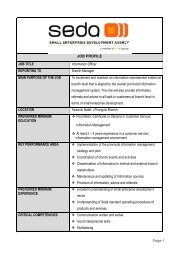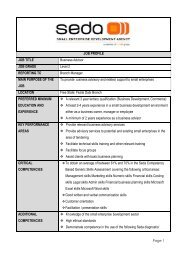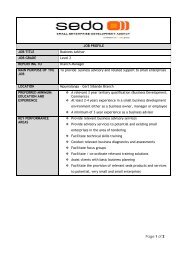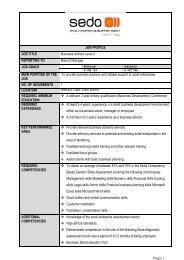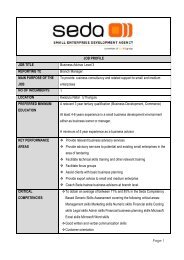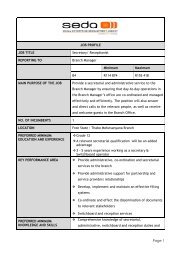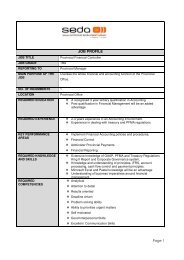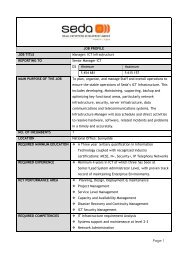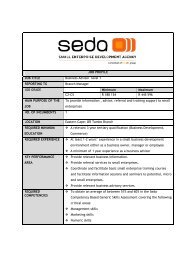Assessment of Cooperatives in the Poultry Industry - 2013.pdf - Seda
Assessment of Cooperatives in the Poultry Industry - 2013.pdf - Seda
Assessment of Cooperatives in the Poultry Industry - 2013.pdf - Seda
Create successful ePaper yourself
Turn your PDF publications into a flip-book with our unique Google optimized e-Paper software.
Research Report: Address<strong>in</strong>g <strong>the</strong> Needs, Opportunities and Challenges <strong>of</strong> <strong>Cooperatives</strong><br />
and Collectively Owned Enterprises <strong>in</strong> <strong>the</strong> <strong>Poultry</strong> and Related Industries<br />
Table 4-11: Interactions <strong>of</strong> Large Retailers with Develop<strong>in</strong>g Farmers<br />
Bus<strong>in</strong>ess<br />
Large Retailer 1<br />
Large Retailer 2<br />
Large Retailer 3<br />
Work with<br />
develop<strong>in</strong>g<br />
farmers?<br />
and<br />
Ma<strong>in</strong> Function (if yes)/ Reason why (if no)<br />
Buyers operate per prov<strong>in</strong>ce and suppliers must be<br />
able to supply <strong>the</strong> entire prov<strong>in</strong>ce. Cannot buy from<br />
different farmers for different stores as this is not<br />
logistically viable.<br />
Independent farmers are encouraged, however,<br />
<strong>the</strong>y must be able to supply on a relatively large<br />
scale. Relationships exist with suppliers and <strong>the</strong>se<br />
are slow to change<br />
Only have corporate suppliers. Distribution and<br />
quantity are problems with smaller farmers.<br />
The above table identifies that <strong>of</strong> <strong>the</strong> three producers contacted, two do not work with develop<strong>in</strong>g<br />
farmers. One retailer does work with <strong>in</strong>dependent farmers; however, this relationship has been built<br />
over many years and requires a certa<strong>in</strong> level <strong>of</strong> production to be <strong>in</strong> place.<br />
Retailer 2 identified <strong>in</strong> Table 4-11 above provided additional <strong>in</strong>formation concern<strong>in</strong>g <strong>the</strong> bus<strong>in</strong>ess<br />
and partner<strong>in</strong>g with develop<strong>in</strong>g farmers. The retailer stated that <strong>the</strong>ir bus<strong>in</strong>ess is geared towards<br />
work<strong>in</strong>g with develop<strong>in</strong>g farmers. They recommended that cooperatives would be <strong>in</strong> a better<br />
position to do bus<strong>in</strong>ess with <strong>the</strong> store if <strong>the</strong>y f<strong>in</strong>d a niche and supply to that; such as organic chicken<br />
and organic eggs, quail, pheasant, etc. The store also stated that <strong>the</strong>y have an Enterprise<br />
Development Department that works towards assist<strong>in</strong>g small bus<strong>in</strong>esses. There are certa<strong>in</strong> criteria<br />
which need to be met and <strong>in</strong> order to supply to <strong>the</strong> store, <strong>in</strong>ternational standards, legislation, and<br />
DNA quality test<strong>in</strong>g must be met. Thus, although this bus<strong>in</strong>ess is <strong>the</strong> most open to buy<strong>in</strong>g <strong>the</strong><br />
products <strong>of</strong> develop<strong>in</strong>g farmers, <strong>the</strong>ir quality standards pose a significant barrier to entry.<br />
The rema<strong>in</strong><strong>in</strong>g two retailers <strong>in</strong>dicated that although <strong>the</strong>y do not<br />
discrim<strong>in</strong>ate aga<strong>in</strong>st any particular bus<strong>in</strong>ess type, small-scale<br />
farmers are not able to meet <strong>the</strong> demands <strong>the</strong>y set for suppliers.<br />
Retailer 1, identified <strong>in</strong> Table 4-11 above, stated that suppliers<br />
must be able to produce sufficient quantities for all stores <strong>in</strong> a<br />
prov<strong>in</strong>ce.<br />
Small-scale farmers are<br />
not able to meet <strong>the</strong><br />
demands set for suppliers<br />
Retailer 3 reasoned that although <strong>the</strong>y would like to work with develop<strong>in</strong>g farmers, two ma<strong>in</strong><br />
challenges are faced with this. The first is distribution; small producers do not have <strong>the</strong> fleets <strong>of</strong><br />
trucks necessary to deliver <strong>the</strong>ir products to all stores <strong>in</strong> a region. Large numbers <strong>of</strong> refrigerated<br />
trucks are required to deliver broilers. The second concern is quantity; small producers simply<br />
cannot meet <strong>the</strong> demands <strong>of</strong> an entire region <strong>of</strong> stores. The store contact person also noted that<br />
quality is a concern regard<strong>in</strong>g eggs. Many small-scale egg producers place <strong>the</strong>ir eggs <strong>in</strong> refrigerated<br />
storage when <strong>in</strong> fact this depletes <strong>the</strong> shelf life <strong>of</strong> <strong>the</strong> eggs. Based on <strong>the</strong>se constra<strong>in</strong>ts; Retailer 3<br />
currently only has large corporate suppliers on <strong>the</strong>ir suppliers list for broilers and eggs.<br />
74 | P a g e U r b a n - E c o n : D e v e l o p m e n t E c o n o m i s t s



